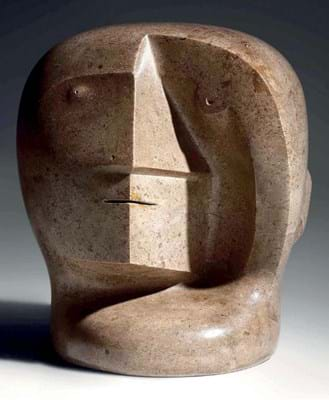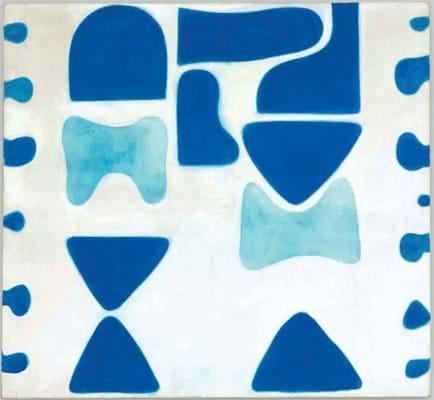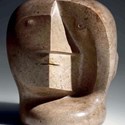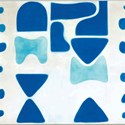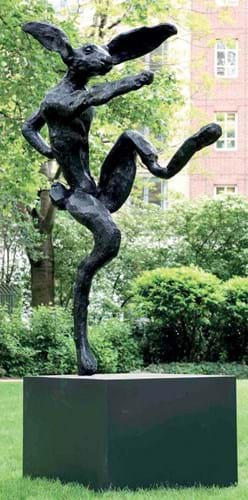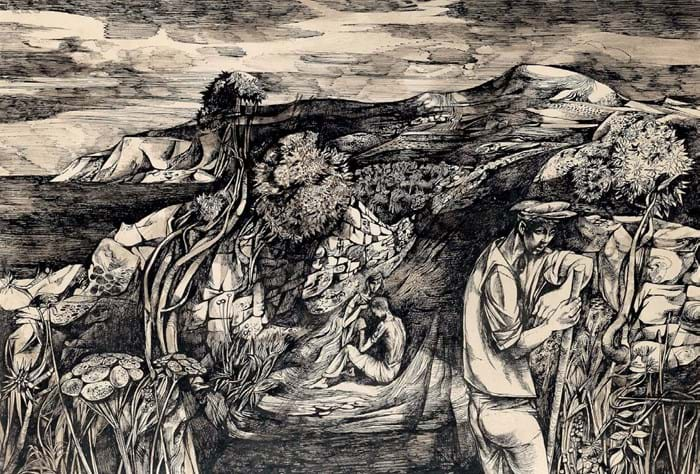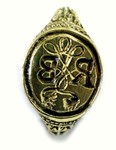Between them, Sotheby’s, Christie’s and Bonhams (25/20/12.5-12.9% buyer’s premium) held eight sales over the course of a fortnight in June, offering an array of material by some of the market’s most lucrative names.
Christie’s led the charge on June 19, posting its strongest evening sale in the category to date with a £21.86m total and a high sell-through rate of 94% from 45 lots.
“It is not just the traditional Modern British buyers that are coming into this market now and paying those prices,” said William Porter, senior director at Christie’s. “Blue-chip pieces are attracting a much wider international audience.”
Christie’s reported bidders from more than 20 countries, across five continents, with major interest coming from British, American, Continental European and Asian buyers.
“There is a real feeling that there’s still value in the Mod Brit market and room to grow for a lot of artists,” Porter added.
Sotheby’s smaller evening offering of 31 lots a week before, on June 12, totalled £10.14m with an 81% sell-through rate.
Frances Christie, Sotheby’s head of modern and post-war British art, said: “The passion for household names such as Hepworth, Moore and Nicholson remains undimmed among collectors across the globe and we found new homes for a number of important artworks that had been cherished in private collections for decades.”
On the same day, Sotheby’s also offered 89 lots by the late British painter and printmaker Howard Hodgkin (1932-2017) in a near sell-out sale and a 31-lot single-owner offering of Scottish Colourist art from the celebrated Harrison collection (see separate Art Market story this edition).
Sensitivity to pricing was a discernible trend to emerge from the latest series, most notably in the stuttering interest shown for more ordinary material where full-blooded estimates had been applied.
Porter said: “There is a big difference between a masterpiece and pieces that come to the market more frequently. These works are far more price-sensitive and clients can pull back if they feel they are too expensive.”
While blue-chip Mod Brit art continues to be in demand from a global market, the balancing act of managing vendor expectations with sensitive pricing, while also procuring top-quality material, remains a challenge for auction houses.
Persuading people to sell their art is another hurdle. Often, long-standing private collections contain works that were bought to be kept and not for investment purposes.
“People love them and unless there is a very good reason, they are not necessarily looking to sell, even if the value has gone up,” added Porter.
Christie’s
Sculpture was a key component at both salerooms but especially at Christie’s, where a unique work by Henry Moore (1898- 1986) topped the series at £3.9m.
The 11in (27cm) high Cubist-inspired carved head, made from Hopton Wood stone and distinguished for its unusual features, had last sold in 1972. Described by Porter as a “once in every 10-year piece”, it was secured by Alan Hobart of the Pyms Gallery who fought off competition from fellow London dealer Daniel Katz, according to The Daily Telegraph.
The large playful bronze hares of Barry Flanagan (1941-2009) also appealed strongly to buyers at Christie’s. The auction house eclipsed its own auction record for the Welsh sculptor with Nijinski Hare, a trademark large 8ft (2.44m) high bronze conceived in 1985 and cast in 1986 in an edition of five. Acquired by the vendor in the year it was cast from the Pace Gallery in New York, it sold to an anonymous buyer above its £700,000-1m estimate at £1.2m.
Hare sculptures also proved popular at Bonhams where Dancing Hares, a 1997 piece by fellow British sculptor Sophie Ryder (b.1963), sold for £70,000 against a £20,000- 30,000 estimate.
Emily Young (b.1951) is another sculptor whose carved stone heads are rising in value on the secondary market. At Christie’s a 3ft 7in (1.10m) head called Cautha, carved in 2012 and acquired directly from the artist’s studio, took £280,000, a comfortable new auction record.
Sotheby’s
The evening auction held in New Bond Street was led by Stanley Spencer’s (1891-1959) monumental Christ Preaching at Cookham Regatta: Punts by the River, part of the artist’s celebrated series that explored the idea of Christ’s presence in his home town of Cookham, Berkshire.
Appearing on the market for the first time since it was acquired in 1959, the year after it was painted, the 3ft 4in x 5ft 1in (1 x 1.54m) oil and pencil on canvas sold to a phone bidder below a punchy £3m-5m guide for £2.8m.
It shared an identical guide with another Cookham Regatta scene that sold for a record £5.3m at Christie’s London in 2013, which was regarded as among the most important paintings by the artist and the one he was working on towards the end of his life.
Stiffer competition emerged for the abstract and semi-abstract paintings of post-war British art by the likes of Ben Nicholson (1894- 1982), William Scott (1913-89) and Victor Pasmore (1908-98), whose works have continued to rise in price over the last few years.
Nicholson’s top entry at Sotheby’s was 1966 (IOS), a later large-scale relief acquired in the 1970s by the vendor from Marlborough Fine Art in London.
The 5ft 1in x 6ft 7in (1.54 x 2.01m) oil on carved hardboard is part of a series of ambitious large-scale reliefs that Nicholson produced shortly after his marriage to the young German photographer Felicitas Vogler and their move to Brissago in Switzerland. It sold to a UK private buyer on top estimate for £1m – a strong price for a work from this later period.
Another Nicholson, a modestly sized table-top composition titled July 1960 (Green and Black), nearly doubled its top estimate to sell to Beaumont Nathan Art Advisory for £330,000.
While Nicholson has surpassed the million-pound barrier, Scott is yet to achieve this auction milestone. Two monumental canvases made their auction debuts at Sotheby’s, both coming from ‘important’ Irish collections.
The more expensive of the two, a blue and white oil on canvas titled Berlin Blues 2 and executed in 1965, sold above estimate to a private buyer for £600,000, the second-highest sum for the artist at auction.
While there is a premium for his blue and white canvases, Scott’s still-lifes from the 1950s still pack the biggest financial punch at auction. According to Art Sales Index, the artist’s auction record stands at £920,000 for a double-sided oil on canvas, Bowls Eggs and Lemons (1950), at Christie’s in June 2008.
The other work, an ochre canvas from 1973 titled Dark Earth Scheme, sold to an anonymous buyer above the £200,000-300,000 guide at £430,000.
Bonhams
At Bonhams, where £3.26m worth of Mod Brit art changed hands on June 13 in New Bond Street, the stand-out entry was John Minton’s (1917-57) neo-romantic work, Summer Landscape.
The large 22in x 2ft 8in (56 x 81cm) pen and ink work shows the abiding influence on Minton of the etchings and drawings of 19th century landscape Romantic painter Samuel Palmer. It was executed in 1945 after visits to south Cornwall.
Matthew Bradbury, Bonhams director of Modern British and Irish art, described the work as “mesmeric… in which the figures and the landscape meld into one. It’s a highly accomplished composition by an artist at the peak of his powers.”
It drew plenty of competition against a £30,000-50,000 guide and was knocked down at £120,000, a new auction record for a work on paper by the artist.
Minton has been performing well on the secondary market in recent years. In 2016, his auction record was broken twice when two large-scale Jamaican paintings sold at Christie’s for premium-inclusive prices of £188,500 and £293,000.
Top spot at Bonhams went to Jack B Yeats’ (1871-1957) vivid green canvas, Donnelly’s Hollow. One of the artist’s larger works, the 2ft x 3ft (61 x 91cm) oil depicts the natural amphitheatre at the Curragh in County Kildare where, in 1815, the Irish boxer Dan Donnelly defeated the English champion, George Cooper.
Boxing was a passion for the sports-mad Yeats, and Donnelly’s Hollow is one in a series of later paintings that revisited the obsessions of the artist’s youth.
It failed to match its punchy £300,000-500,000 guide and sold for £280,000. The lack of a dominant figure in the composition may have had some bearing on the price.


